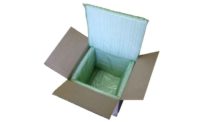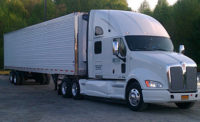Sustainable Tips for Truck Transportation
True energy savings extend beyond the rig and trailer for cold chain logistics.

It's worth the time and money to research packaging and palletization that allows you to maximize your positions on a trailer. Photo courtesy of iStock.

Karl Bratnober, VP at Trademark Transportation.

Pooling similar freight regionally can potentially reduce over-the-road trucks consuming unnecessary energy. Photo courtesy of iStock.



The increased awareness, research, and corporate social responsibility regarding our effects on the environment means that now, more than ever, is the time to look for ways to improve energy efficiencies. Whether you are a small organic food shipper or a large food distribution company, we have to look at all aspects of our business for ways to steward the environment.
One of the more complex areas of a business to tackle this issue is cold chain transportation. The industry has been making necessary improvements, and technological advancements to equipment have moved the needle significantly.
However, are there ways to look at our impact on the environment beyond thinking about the trucks themselves? I believe that several cold chain strategies for transportation (going beyond a truck's efficiency) will drive energy savings for you and your customers.
Vendor Alignment
Having the right set of vendors should be your first step in analyzing your logistics. Are you choosing vendors that align with your values? A potential oversight could be spending time and energy to make sure that your facilities and equipment are efficient and entrusting your transportation to a vendor that may be offsetting your efforts. Businesses work hard to develop their mission and values. While you are selecting your service providers, ensure that your transportation network is motivated to participate in your environmental goals. Vendors will often advertise their participation in the EPA SmartWay program. Take the time needed to qualify and understand how your vendors move your product from A to B. A highly vetted network is an essential component of any energy initiative.
Route Optimization
My fifth-grade teacher, Mrs. Johnson, taught me the Archimedes principle, "the shortest distance between two points is a straight line," but this can be more complex when it comes to freight. This saying does not always work in the real world, but the strategy to be gleaned from the old Greek mathematician is that route optimization is essential to energy efficiency. Managing a TL routes' efficiency is more straightforward than other modes, but it is a blind spot to assume that multi-stop truckloads and LTL are moving in the most efficient manner possible. Managing these modes is where technology can create opportunities for improvement. Route planning tools lead to improved fuel efficiencies, ensuring that your traffic moves in the “shortest” line possible. If you are still routing your shipments using antiquated processes and systems, you have a unique opportunity to save energy by updating your routing capabilities.
Load Strategies
Businesses tend to think of their logistics based on cost per pound. What if you thought of your freight in terms of energy efficiency per pound as well? While it is true that the efficiency of the reefer unit, trailer, and tractor play a key role in energy consumption, looking at the utilization of that equipment can also have an impact. Simply loading a truck more efficiently could be a step toward your green goals.
Are you leaving space on a truck? One potential area of improvement for your cold chain may be looking at palletization. Spend the time and money to research packaging and palletization that allows you to maximize your positions on a trailer. Food shippers frequently use multiple positions unnecessarily on a truck instead of utilizing the cube from our experience. Take a second look at how you are building your pallets.
Regional Freight Consolidation
Consolidation and pool distribution programs are another way to capitalize on trailer capacity. Pooling like freight regionally will reduce over-the-road trucks consuming potentially unnecessary energy. Sending multiple shipments on a single line-haul truck to their destination could benefit your transportation's operational efficiency. Procurement and sales strategies coupled with sailing schedules are a cornerstone to developing a program. Are you considering your cold chain strategy to reduce carbon emissions? Having an inbound consolidation program to gather ingredients from multiple suppliers or a pool distribution program that will deliver to customers in distinct regions will reduce your energy consumption by streamlining your logistics and optimizing trailer capacity.
Recently we have seen a significant market shift in LTL quantities. As the marketplace continues to change and we see more variety in the frozen aisle, there creates an increase in smaller, more widely scattered shipments. While I understand the difficulty in navigating a customer's needs and timing, simply planning ahead can change the impact that you are having. Frequent and unnecessary energy use is sending a TL to handle an expedited shipment that, with proper planning, could be consolidated with other orders going to the same region. Less than truckload shipments take upfront planning, but providers can send similar shipments to an area of the country together, cutting down on the energy used on your product alone with advanced notice. As your sales team talks with customers, as you navigate your inventory and production runs, and as your planners route your shipments, think creatively in a way that can protect your environmental values with a cohesive plan.
Calculate Your CO2 Emissions
The first 15 years of my career, I worked in the non-profit sector while always being connected and serving on the board of my family's logistics company. I spent time learning about opportunities for the corporate world to partner with social initiatives. Over the last few decades, there has been a push for businesses to engage in social issues, and there are still opportunities to look at our corporate influence globally. Setting up a CSR (Corporate Social Responsibility) program to offset your carbon emissions with strategic partners is one method of reducing your organization's impact.
If you do a small amount of research, you can quickly discover your total CO2 emissions. For example, the Environmental Defense Fund (EDF) suggests calculating your freight emissions by this simple formula: Distance x Weight x Emissions Factor = Greenhouse Gas Emissions. Here is the EDF’s example for a 1,000-mile shipment at 20 tons:
-
Step 1: Determine the total amount of ton-miles. Multiply 1,000 miles times 20 tons, which gives us a total of 20,000 ton-miles.
-
Step 2: Get the weight-based truck emissions factor for a freight truck. The average freight truck in the U.S. emits 161.8 grams of CO2 per ton-mile.
-
Step 3: Multiply this emissions factor with the total ton-miles {161.8 X 20,000), which gives us a total of 3,236,000 grams of CO2.
-
Step 4: Convert the total grams into metric tons. Metric tons are the standard measurement unit for corporate emissions of greenhouse gases. There are 1,000,000 grams in a metric ton. To convert our answer from step three, we divide it by 1,000,000.
- Result: This gives us 3.24 metric tons of CO2 for this one move.
Once you find your total freight CO2 emissions turn your attention to carbon offsets, reducing CO2 and lowering greenhouse gas levels. In the food industry, I suggest investing in sustainable farming practices. Another strategy would be to partner with conservation or restoration initiatives. Here is a place to search for potential partners and find qualified charities.
Technology and government policy cannot be the only thing driving energy efficiency within the cold chain. By critically thinking about our social responsibility and these solutions, the food industry can develop a more robust strategy to going green within transportation and logistics. What will your next steps be?
Looking for a reprint of this article?
From high-res PDFs to custom plaques, order your copy today!









